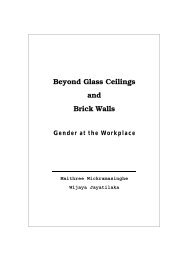SETP No. 14 The Economic Value of Incremental Employment in the ...
SETP No. 14 The Economic Value of Incremental Employment in the ...
SETP No. 14 The Economic Value of Incremental Employment in the ...
You also want an ePaper? Increase the reach of your titles
YUMPU automatically turns print PDFs into web optimized ePapers that Google loves.
8.10 Second, <strong>the</strong> analysis did not take <strong>in</strong>to account <strong>the</strong> potential for learn<strong>in</strong>g on <strong>the</strong> job<br />
and o<strong>the</strong>r labour productivity ga<strong>in</strong>s that can be achieved us<strong>in</strong>g a programme<br />
approach to project plann<strong>in</strong>g. Many commentators advocate <strong>the</strong> virtues <strong>of</strong> us<strong>in</strong>g a<br />
programme approach for labour-based methods and <strong>in</strong>creas<strong>in</strong>g labour usage <strong>in</strong><br />
an <strong>in</strong>cremental and f<strong>in</strong>ancially viable manner.<br />
8.11 A second strand <strong>of</strong> <strong>the</strong> <strong>in</strong>vestigation focussed on <strong>the</strong> macroeconomic<br />
consequences <strong>of</strong> <strong>the</strong> choice between labour and equipment-based methods with<br />
<strong>the</strong> objective <strong>of</strong> determ<strong>in</strong><strong>in</strong>g whe<strong>the</strong>r labour-based methods have macroeconomic<br />
advantages over us<strong>in</strong>g mach<strong>in</strong>es. In most develop<strong>in</strong>g countries <strong>the</strong>re is little<br />
debate and labour-based methods have far greater macroeconomic benefits than<br />
equipment-based techniques. South Africa is different. South Africa makes its<br />
own earthmov<strong>in</strong>g equipment, produces a substantial amount <strong>of</strong> its own oil,<br />
produces spare parts locally, and has specialised mechanics and technicians<br />
who are residents not contracted expatriates. Hence macroeconomic estimates<br />
were made for labour and equipment-based methods.<br />
8.12 This part <strong>of</strong> <strong>the</strong> analysis was challenged by limited <strong>in</strong>formation on locally<br />
produced equipment and local content had to be estimated with<strong>in</strong> bounded<br />
assumptions.<br />
8.13 It is shown under <strong>the</strong>se assumptions that labour-based methods have<br />
considerable macroeconomic advantages over equipment-based methods for<br />
both fully imported and locally made wheeled loaders. However this advantage<br />
becomes marg<strong>in</strong>al when <strong>the</strong> capital cost <strong>of</strong> <strong>the</strong> wheeled loader has been<br />
amortised.<br />
8.<strong>14</strong> Better <strong>in</strong>formation on <strong>the</strong> cost <strong>of</strong> equipment might prove that <strong>the</strong>re is no<br />
macroeconomic advantage to labour-based methods.<br />
8.15 One <strong>of</strong> <strong>the</strong> most debated issues is <strong>the</strong> sav<strong>in</strong>g <strong>of</strong> foreign exchange. <strong>The</strong>re is no<br />
doubt that a reduction <strong>in</strong> imported capital equipment will save on foreign<br />
exchange. This foreign exchange is <strong>the</strong>n available to fund o<strong>the</strong>r k<strong>in</strong>ds <strong>of</strong> imports<br />
or to be kept <strong>in</strong> <strong>the</strong> country and fund local production. It should be recognised<br />
that, if <strong>the</strong>re are cost premiums <strong>in</strong>volved, <strong>the</strong>se sav<strong>in</strong>gs on foreign exchange are<br />
at <strong>the</strong> expense <strong>of</strong> standards <strong>of</strong> liv<strong>in</strong>g.<br />
8.16 A policy conflict exists if it occurs that labour and equipment-based methods have<br />
similar macroeconomic effects and labour-based methods cost more. This conflict<br />
is between <strong>the</strong> promotion <strong>of</strong> a demonstrated comparative advantage <strong>in</strong> <strong>the</strong><br />
production <strong>of</strong> construction equipment and <strong>the</strong> generation <strong>of</strong> economic<br />
empowerment and a less skewed distribution <strong>of</strong> <strong>in</strong>come. In this case <strong>the</strong> choice <strong>of</strong><br />
labour-based methods is based on <strong>the</strong> argument that equipment-based methods<br />
prevent <strong>the</strong> very poor from participat<strong>in</strong>g <strong>in</strong> <strong>the</strong> formal economy. <strong>The</strong>y are<br />
<strong>the</strong>refore marg<strong>in</strong>alised and disempowered. Hence labour-based methods have<br />
positive externalities that go beyond anyth<strong>in</strong>g that can be measured us<strong>in</strong>g<br />
conventional macroeconomic techniques.<br />
8.17 <strong>The</strong> overwhelm<strong>in</strong>g case that must be made for us<strong>in</strong>g labour-based methods is <strong>the</strong><br />
contribution it will make to economic empowerment. Roads, dams and o<strong>the</strong>r<br />
<strong>in</strong>frastructure are good for <strong>the</strong> regional economy and will allow it to grow. Us<strong>in</strong>g<br />
labour-based methods will generate jobs and provide <strong>in</strong>comes fur<strong>the</strong>r promot<strong>in</strong>g<br />
<strong>the</strong> regional economy. Involv<strong>in</strong>g local communities will help <strong>in</strong> capacity build<strong>in</strong>g.<br />
Us<strong>in</strong>g small and emergent contractors will generate susta<strong>in</strong>able <strong>in</strong>comes and<br />
opportunities.<br />
62
















